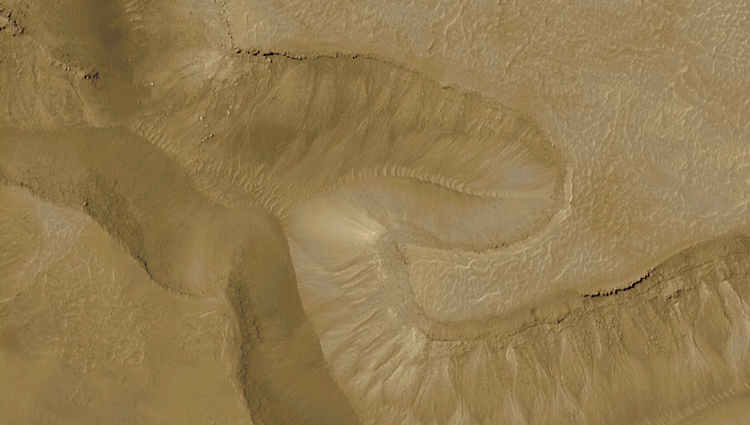Martian Water vs. The Volcanoes
What built the famous canals on Mars?
Image

(ISNS) -- For decades NASA has been "following the water" on Mars with hopes of finding signs of alien life there; or at least signs that future colonists won't die of thirst. Now a Texas geologist has dared to revive an old, almost heretical idea -- backed up with all the latest data -- that the Red Planet has been bone dry for billions of years.
Mars' spectacular grand canyons were not carved by catastrophic floods, says Texas Tech's David Leverington, but by slippery, low-viscosity lavas. This lava hypothesis fits happily within a wider geological framework of Mars and compares well with similar channel-like features on the moon and Venus, he said.
If Leverington is right, the odds of life on Mars plummet to near zero. But that's a big "if." Many veteran Mars researchers are far from buying the lava story and are still pretty certain that water played a significant part in sculpting the compelling 1,200-mile long, 60-mile wide outflow channels that stunned the world when they were first imaged by Viking spacecraft in the late 1970s.
Holes In The Water
Leverington's approach, as explained in his soon-to-be published paper in the Sept. 2011 issue of the journal Geomorphology, is to take apart some of the major assumptions of the "aqueous" models used to explain how water could have scoured out the outflow channels.
First there is the matter of the sources of all the water. Some Mars water advocates have calculated that the volume of water would, in some cases, need to exceed those of the greatest rivers on Earth, perhaps being more on par with something like the Atlantic Ocean's Gulf Stream current.
"The question is: How do you get that volume of water?" said Leverington. "How do you move it quickly enough to rush out at a rate to carve channels like these?"
There are no huge empty lake beds at the heads of the outflow channels. So researchers have hypothesized vast permafrost-sealed aquifers in extremely porous, permeable ground that was suddenly breached by meteor impacts, faulting or upwards movements of hot magma in the Martian crust. In order for that scenario to work other researchers have calculated that the permeability of the Martian crust would need to be 1-10 million times greater than seems evident or likely, he said.
Another puzzle is the location of the starting points of the outflow channels. They tend to start up on the flanks of volcanoes. That doesn't fit the water hypothesis, said Leverington, because outflows of such huge volumes of water would be more likely from breaches at lower elevations so that there is plenty of "head" uphill of the breach pushing the water out below.
One more thorn in the side of the aqueous hypothesis, Leverington said, is the mineralogy of Mars. There are few sediments and minerals that are consistent with a wet planet. Except for some clays found in rocks from the very earliest period in Mars history, which are far older than the outflow channels, the minerals found on Mars are not the kind that would survive contact with water and would reform as different minerals if the planet cycled through wet and dry periods. In other words, these minerals would not exist if water was common anytime in the near geologic past.
"I would argue that all of these diverse types of data point firmly at volcanic mechanisms," said Leverington.
Conflicting Views
But not so fast, says highly respected veteran Mars researcher Victor Baker, of the University of Arizona's Lunar and Planetary Laboratory in Tucson, Ariz. Just because there are some problems with the water hypothesis is no reason to throw it out entirely, he said. What's more, you have to be careful not only when you compare Martian features to Earth's, but also to other planets.
"He's reasoning on the features of Moon and Venus when we don't know the causes of those features either," said Baker.
So while there might be similarities, it's not at all clear that erosive, low viscosity lavas are the common cause. "It's very obvious that immense flows of water and lava have been involved," said Baker.
Baker also warns against falling wholeheartedly for the lava hypothesis just because it seems simpler. "To say something is better because it's simpler is how physicists think," said Baker. That reasoning is less successful in the more complicated world of geology. "Simplicity is a human artifact," he said.
This might sound rather philosophical, but it comes from Baker's decades of watching and participating in many Mars water controversies.
"Mars is great because it has a character of familiarity and strangeness," said Baker.
That, at least, is something on which he and Leverington agree.
"Previously I had a very terrestrial view of the Martian surface," said Leverington. On Earth, water is the great molder of landscapes, after all. But after staring at enough images of strange channels on the moon and Venus, his perspective changed. "Now I try to get away from the provincialism that we have as inhabitants of this water world."
